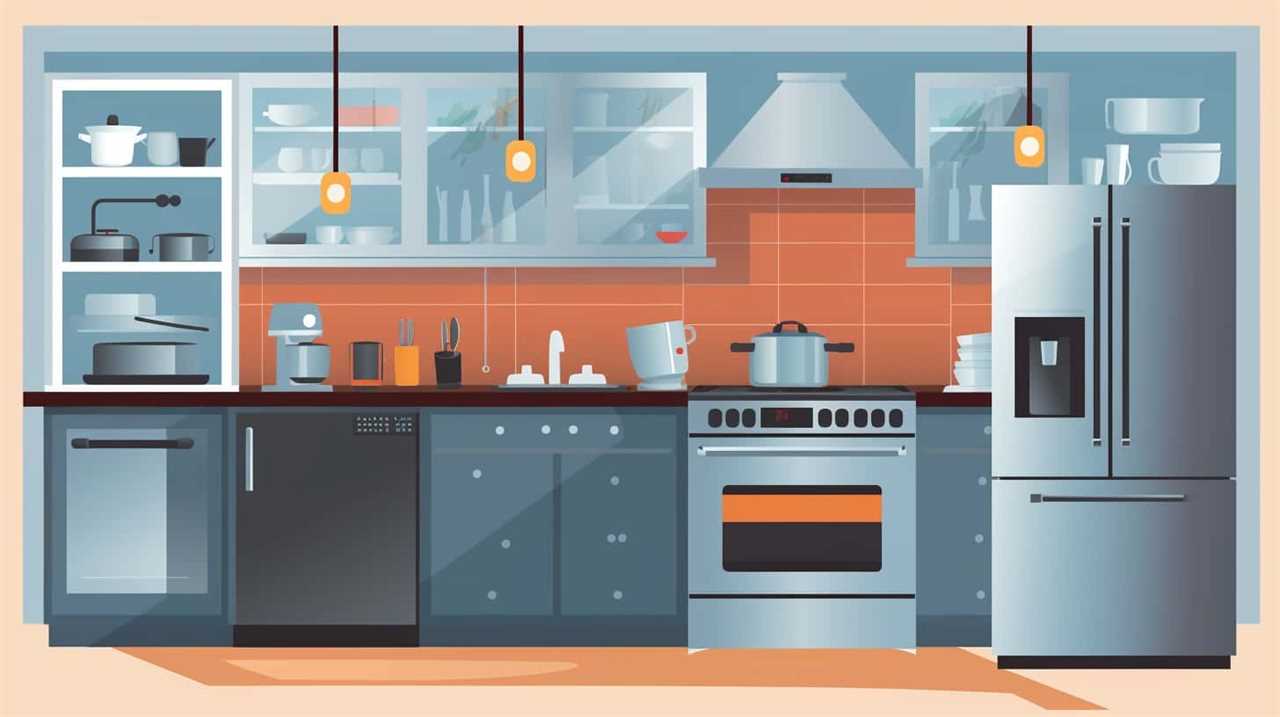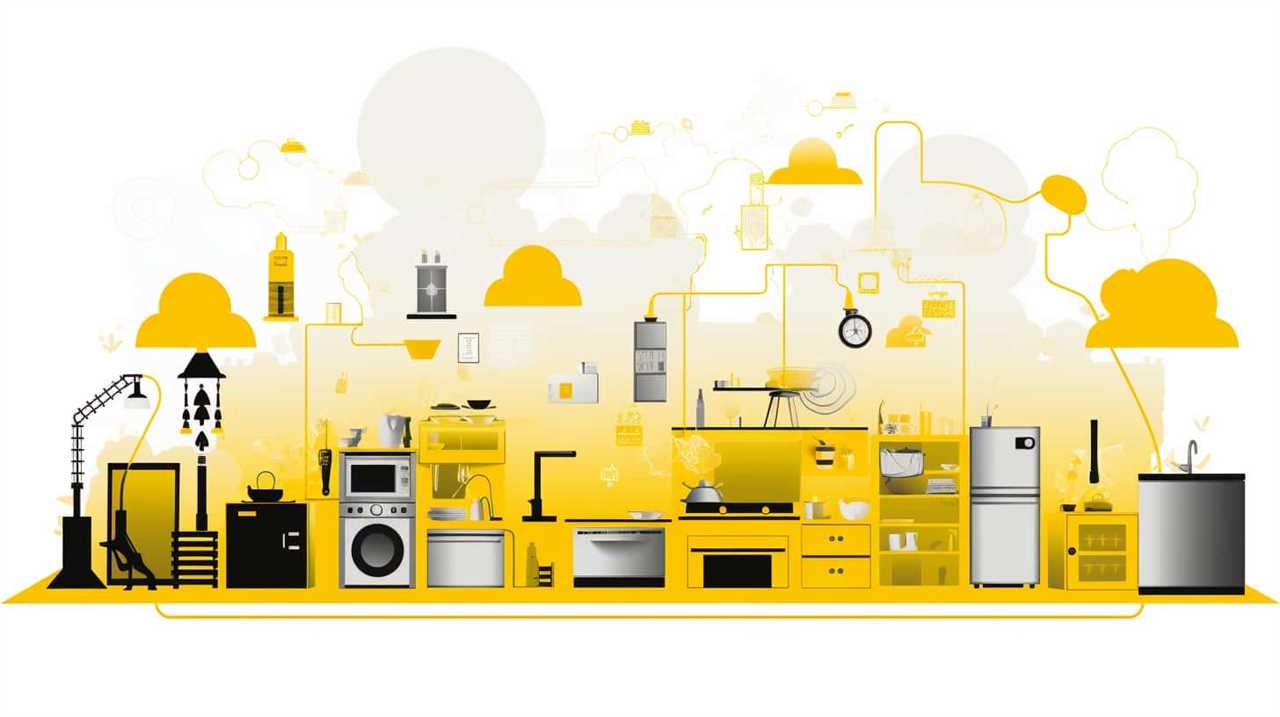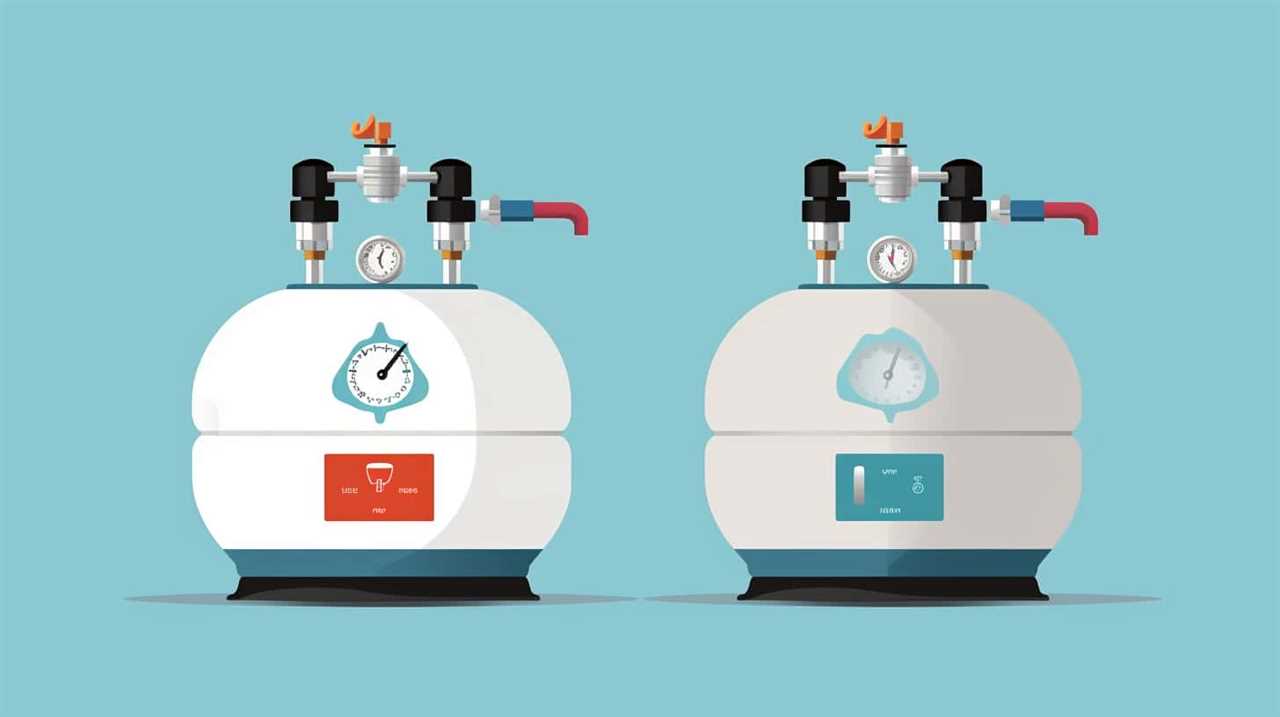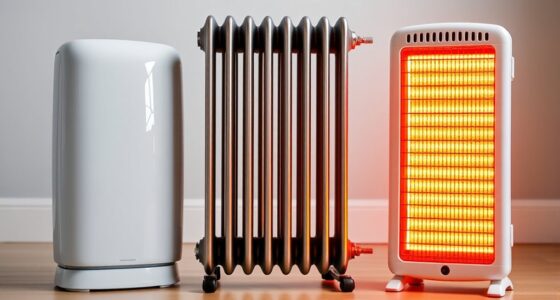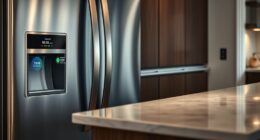Are you concerned about the price of your energy bills? We recognize the annoyance of high costs, but don’t worry! We have the answer for you: top energy-efficient home appliances.
By investing in these appliances, we can save a significant amount of money while also reducing our carbon footprint. From refrigerators to washing machines, dishwashers to air conditioners, there is a wide range of options available that can help us achieve both savings and sustainability.
Additionally, LED light bulbs, smart thermostats, and energy-efficient windows are also excellent choices to maximize our energy efficiency.
So, let’s dive in and explore the world of energy-efficient home appliances, and start saving both money and the environment!

Key Takeaways
- Energy-efficient appliances in the kitchen, such as refrigerators and dishwashers, can significantly reduce energy consumption and save money on utility bills.
- Cooling solutions like energy-efficient air conditioners with higher SEER ratings and smart thermostats can optimize energy usage and reduce greenhouse gas emissions.
- Switching to LED light bulbs for lighting can save energy, lower electricity bills, and reduce carbon emissions.
- Installing energy-efficient water heating systems like solar water heaters can reduce reliance on non-renewable energy sources and qualify for government incentives and tax credits.
Refrigerators
When it comes to reducing energy consumption in our homes, one area where we can make a significant impact is by choosing energy-efficient refrigerators. Energy-efficient compact refrigerators not only help us save on our energy bills but also contribute to a greener environment. These refrigerators are designed with advanced technologies that optimize energy usage without compromising performance.
One option to consider is smart refrigerators. These appliances are equipped with innovative features that allow us to control and monitor their functions remotely. With the help of smartphone apps, we can adjust temperature settings, receive alerts, and even create shopping lists. Smart refrigerators also come with energy-saving modes that automatically adjust cooling levels based on our usage patterns.
Furthermore, energy-efficient compact refrigerators are designed to minimize heat transfer, ensuring that the cold air stays inside and the warm air stays out. This not only helps in maintaining a consistent temperature but also reduces the workload on the compressor, resulting in lower energy consumption.
In conclusion, opting for energy-efficient compact refrigerators, such as smart refrigerators, can significantly reduce our energy consumption and contribute to a more sustainable future.

Now, let’s move on to the next section and explore another important home appliance: washing machines.
Washing Machines
When it comes to energy-efficient washing machines, there are a few key points to consider.
First, water-saving washing machines are designed to use less water per cycle, reducing both water consumption and utility costs.
Second, energy-efficient spin cycles help to remove excess water from clothes, reducing drying time and energy usage.
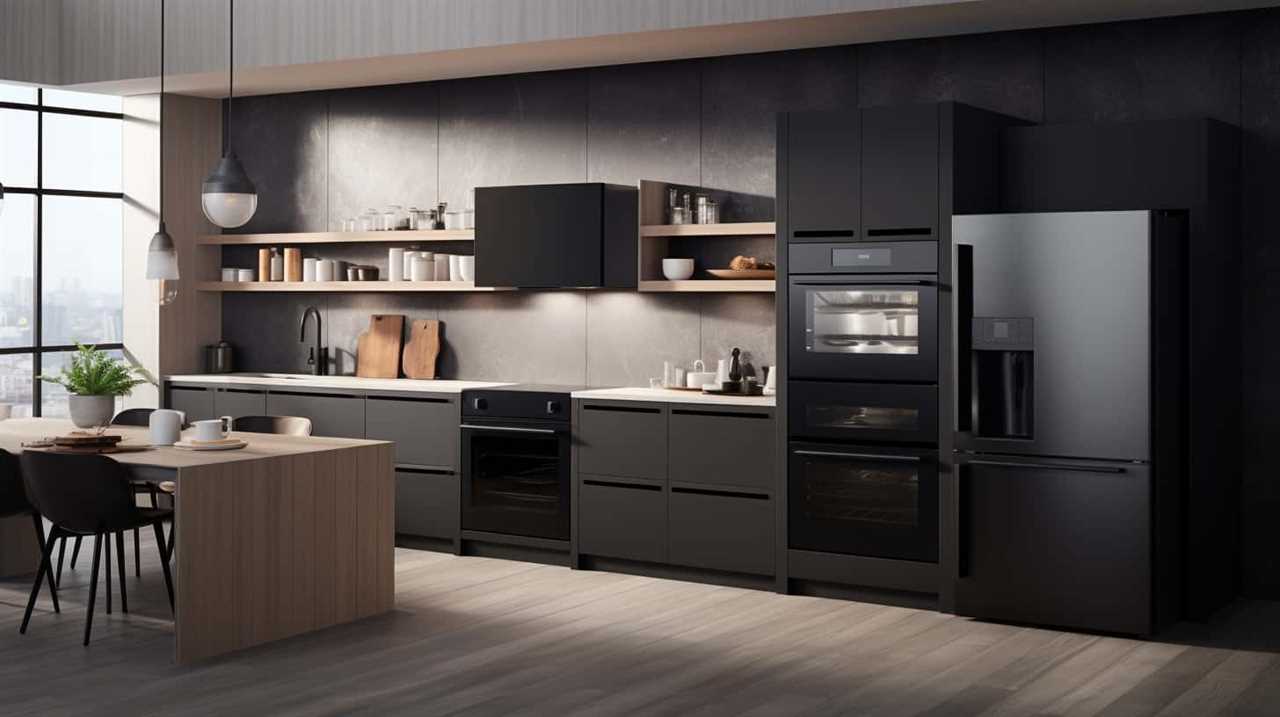
Lastly, using eco-friendly detergent options can further contribute to energy savings and reduce environmental impact.
Water-Saving Washing Machines
To maximize water savings, we recommend investing in water-saving washing machines. These innovative appliances have advanced features that help reduce water consumption without compromising on performance. With the increasing focus on sustainability and conservation, water-saving washing machines are a practical choice for environmentally conscious individuals.
Water-saving washing machines are designed to use less water compared to traditional models. They utilize technologies such as load sensors and adjustable water levels to determine the optimal amount of water needed for each load. This not only saves water but also reduces energy consumption, as less water needs to be heated.
By investing in water-saving washing machines, you can contribute to water conservation efforts in your home. Along with other water-saving measures such as smart irrigation systems and rainwater harvesting, these appliances can make a significant impact on your water usage and utility bills.

Energy-Efficient Spin Cycles
Our top energy-efficient washing machines offer efficient spin cycles that significantly reduce energy consumption. These machines are designed to maximize the removal of excess water from your laundry, reducing the time it takes for your clothes to dry. By using an energy-efficient spin cycle, you can save both time and money.
In addition to the energy-efficient spin cycles, it’s important to consider using energy-efficient dryers and implementing energy-saving laundry techniques to further reduce your energy consumption. By using lower heat settings, avoiding overloading the dryer, and cleaning the lint trap regularly, you can maximize the efficiency of your dryer and save energy.
Now that we’ve discussed the importance of energy-efficient spin cycles and energy-saving laundry techniques, let’s explore eco-friendly detergent options.
Eco-Friendly Detergent Options
We recommend using a small amount of eco-friendly detergent in our energy-efficient washing machines to maximize cleaning power and minimize environmental impact. When it comes to choosing the right detergent for your laundry needs, consider these eco-friendly options:
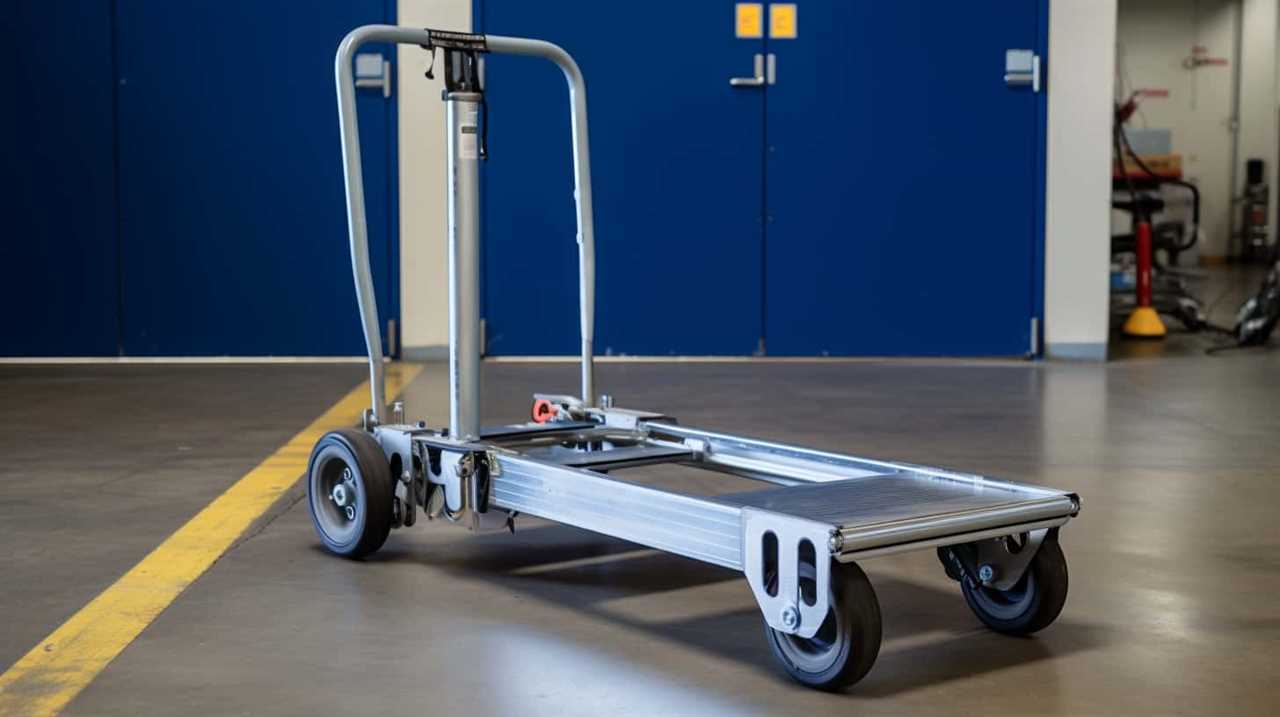
- Plant-based detergents: Look for detergents made from natural ingredients such as coconut oil or plant extracts. These products are biodegradable and free from harsh chemicals, making them safer for both you and the environment.
- Fragrance-free detergents: Many conventional laundry detergents contain artificial fragrances that can cause skin irritation and contribute to air pollution. Opt for fragrance-free options to reduce your exposure to harmful chemicals and minimize your carbon footprint.
- Concentrated detergents: Using concentrated detergents not only reduces packaging waste but also requires less energy to produce and transport. These highly effective formulas allow you to use smaller amounts of detergent while still achieving excellent cleaning results.
By choosing eco-friendly laundry options and natural cleaning products, you can make a positive impact on the environment and promote sustainability in your daily routine.
Now, let’s move on to discussing eco-friendly options for dishwashers.
Dishwashers
The dishwasher’s energy-efficient features save us money and reduce our environmental impact. Energy efficient dishwashers are designed to use less water and electricity compared to older models, making them a smart choice for eco-conscious individuals.
By using a dishwasher, we can benefit from a variety of advantages. First, dishwashers not only clean our dishes thoroughly but also sanitize them, eliminating harmful bacteria and reducing the risk of foodborne illnesses. Additionally, using a dishwasher saves us time and effort, as we don’t have to hand wash and dry each dish individually. This allows us to spend more time on other activities or simply relax.
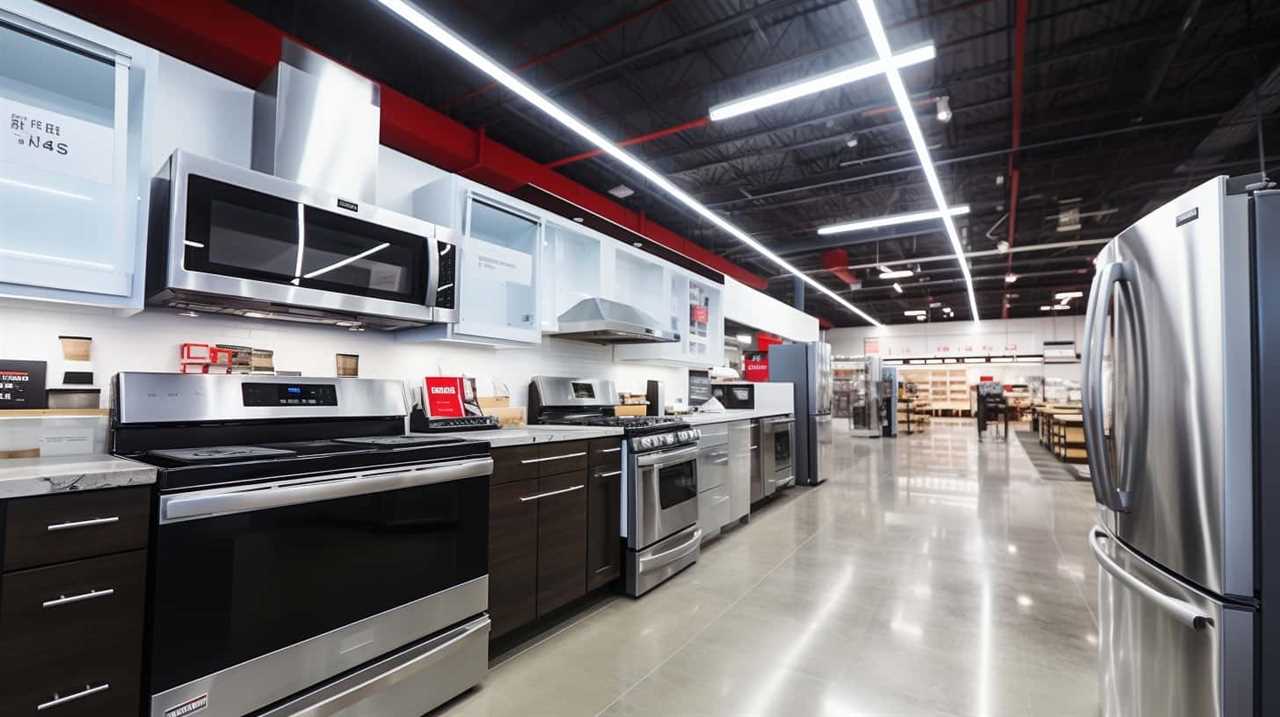
Moreover, energy efficient dishwashers often come with features like delay start and sensor technology, which further optimize energy consumption by running the dishwasher when electricity rates are lower or adjusting the cycle length based on the load’s dirtiness.
In conclusion, investing in an energy efficient dishwasher not only brings convenience to our daily lives but also helps us contribute to a greener future by conserving resources and reducing our carbon footprint.
Now, let’s move on to discussing another essential home appliance: air conditioners.
Air Conditioners
When it comes to air conditioners, there are several cost-effective options available that can help save on energy bills.

We’ll discuss energy-saving cooling solutions that are designed to be more efficient and environmentally friendly.
Cost-Effective AC Options
As we explore cost-effective AC options (air conditioners), it’s essential to consider the energy efficiency ratings of different models. Here are three cost-saving AC units that provide energy-efficient cooling options:
- Inverter Air Conditioners: These units use variable speed compressors that adjust their power according to the cooling needs, resulting in reduced energy consumption and lower electricity bills.
- Window Air Conditioners with Energy Star Certification: These units meet strict energy efficiency guidelines set by the Environmental Protection Agency (EPA). They consume less energy while providing effective cooling, making them a cost-effective choice.
- Ductless Mini-Split Air Conditioners: These units are highly efficient since they cool individual rooms or zones rather than the entire house. They allow for precise temperature control and can help save on energy costs.
Energy-Saving Cooling Solutions
Continuing our exploration of cost-effective AC options, let’s now delve into energy-saving cooling solutions for air conditioners.
To reduce energy consumption and lower electricity bills, consider using energy efficient fans in conjunction with your air conditioning system. These fans can help circulate cool air throughout the room, allowing you to set your AC at a higher temperature without sacrificing comfort.

Another innovative solution is solar powered cooling. By harnessing the power of the sun, solar powered air conditioners can significantly reduce energy usage. These systems utilize solar panels to generate electricity, which is then used to cool your home. Although they may require a higher upfront investment, solar powered cooling solutions can provide substantial long-term savings while also reducing your carbon footprint.
Eco-Friendly Cooling Appliances
Let’s explore eco-friendly cooling appliances, specifically air conditioners, that can help us save energy and reduce our carbon footprint. When it comes to green cooling technologies and sustainable cooling solutions, there are a few options to consider:
- Inverter Air Conditioners: These appliances use variable speed compressors that adjust the cooling output according to the room’s temperature. This ensures energy efficiency and reduces energy wastage.
- Smart Thermostats: These devices allow you to control your air conditioner remotely and schedule temperature adjustments. By optimizing cooling settings based on your usage patterns, smart thermostats help save energy and reduce costs.
- Energy Star Certified Air Conditioners: Look for the Energy Star label when purchasing an air conditioner. These appliances meet strict energy efficiency guidelines set by the Environmental Protection Agency, reducing greenhouse gas emissions and saving you money on energy bills.
Water Heaters
We frequently use energy-efficient water heaters to save on utility costs in our homes.
One way to reduce energy consumption is by installing energy-efficient showerheads. These showerheads are designed to use less water without compromising on the water pressure. By using less hot water, we can significantly reduce the amount of energy needed to heat the water, leading to lower utility bills.
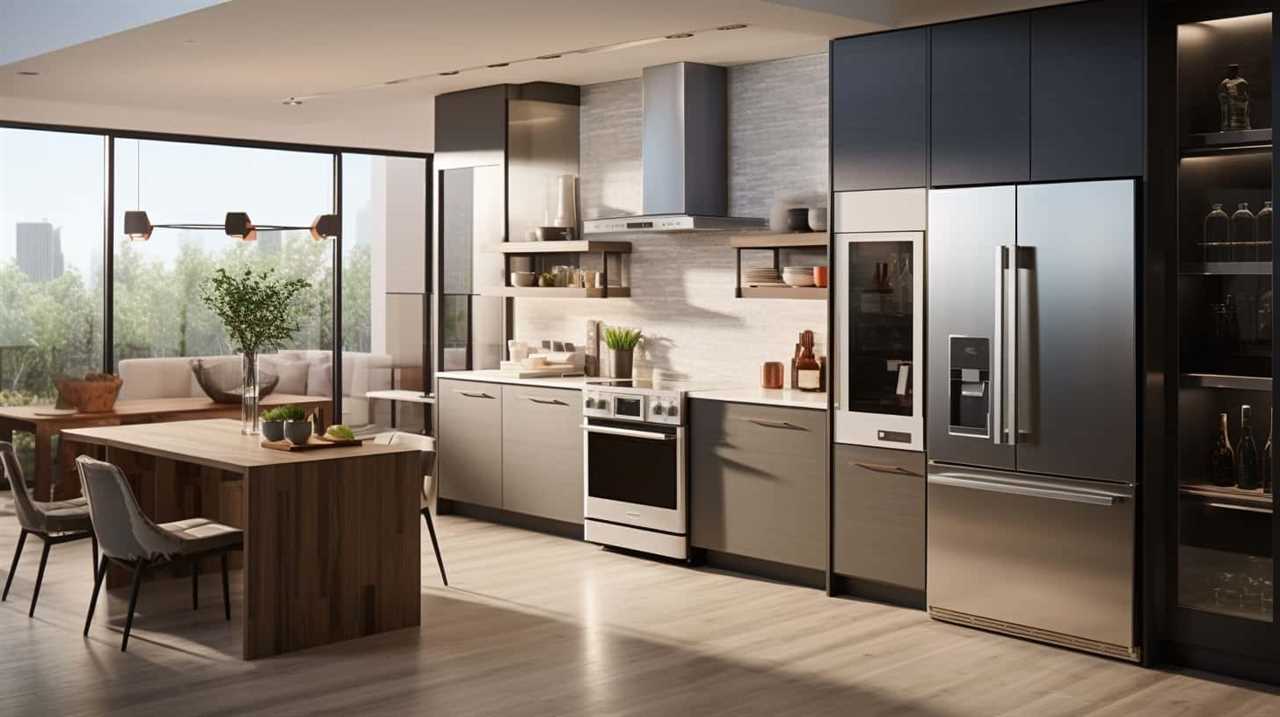
Another option for energy-efficient water heating is solar water heaters. These systems use sunlight to heat the water, eliminating the need for electricity or gas. Solar water heaters are a sustainable and cost-effective alternative to traditional water heaters. They harness the power of the sun to heat the water, reducing our reliance on non-renewable energy sources and reducing our carbon footprint. Additionally, solar water heaters often come with government incentives and tax credits, making them even more affordable.
Ovens and Stoves
To maximize energy savings in our homes, it’s essential to consider the efficiency of our ovens and stoves. These kitchen appliances consume a significant amount of energy, making it crucial to invest in energy-efficient options. Here are three energy-saving tips for ovens and stoves:
- Energy-efficient ovens: Look for ovens with an ENERGY STAR rating, indicating that they meet strict energy efficiency guidelines. These ovens are designed to use less energy while still providing excellent cooking performance. They often feature features like convection cooking, which circulates hot air to reduce cooking time and save energy.
- Induction cooktops: Consider replacing your traditional electric or gas stove with an induction cooktop. Induction technology uses magnetic fields to heat the cookware directly, resulting in faster cooking times and greater energy efficiency. These cooktops also offer precise temperature control and are safer to use since they don’t generate a flame or get hot to the touch.
- Eco-friendly stove options: Opt for stoves that utilize renewable energy sources such as solar power or biomass. These eco-friendly stoves can significantly reduce your carbon footprint and contribute to a more sustainable home.
By choosing energy-efficient ovens and eco-friendly stove options, you can lower your energy consumption and save money on your utility bills.
Now, let’s move on to the next section, where we’ll explore the benefits of LED light bulbs.

LED Light Bulbs
LED light bulbs offer significant energy savings and are a cost-effective choice for illuminating your home. One of the main benefits of LED light bulbs is their energy efficiency. Compared to traditional incandescent bulbs, LED bulbs consume significantly less energy while producing the same amount of light. This means that by switching to LED light bulbs, you can reduce your energy consumption and lower your electricity bills.
LED bulbs also have a longer lifespan than traditional bulbs. On average, LED bulbs can last up to 25 times longer, which means fewer bulb replacements and less waste. Additionally, LED bulbs are more durable and resistant to shocks and vibrations, making them a reliable choice for various applications.
When it comes to installation, LED light bulbs are easy to install and compatible with most existing fixtures. However, it’s important to consider a few tips to maximize their efficiency. First, make sure to choose the right bulb size and shape for your fixture. Second, check the color temperature of the bulb to ensure it matches your desired lighting ambiance. Finally, consider using dimmer switches or smart lighting controls to further optimize energy savings.
Smart Thermostats
Smart thermostats are an excellent choice for optimizing energy efficiency in your home. These technologically advanced devices offer a range of benefits that can help you save money and reduce your environmental footprint.
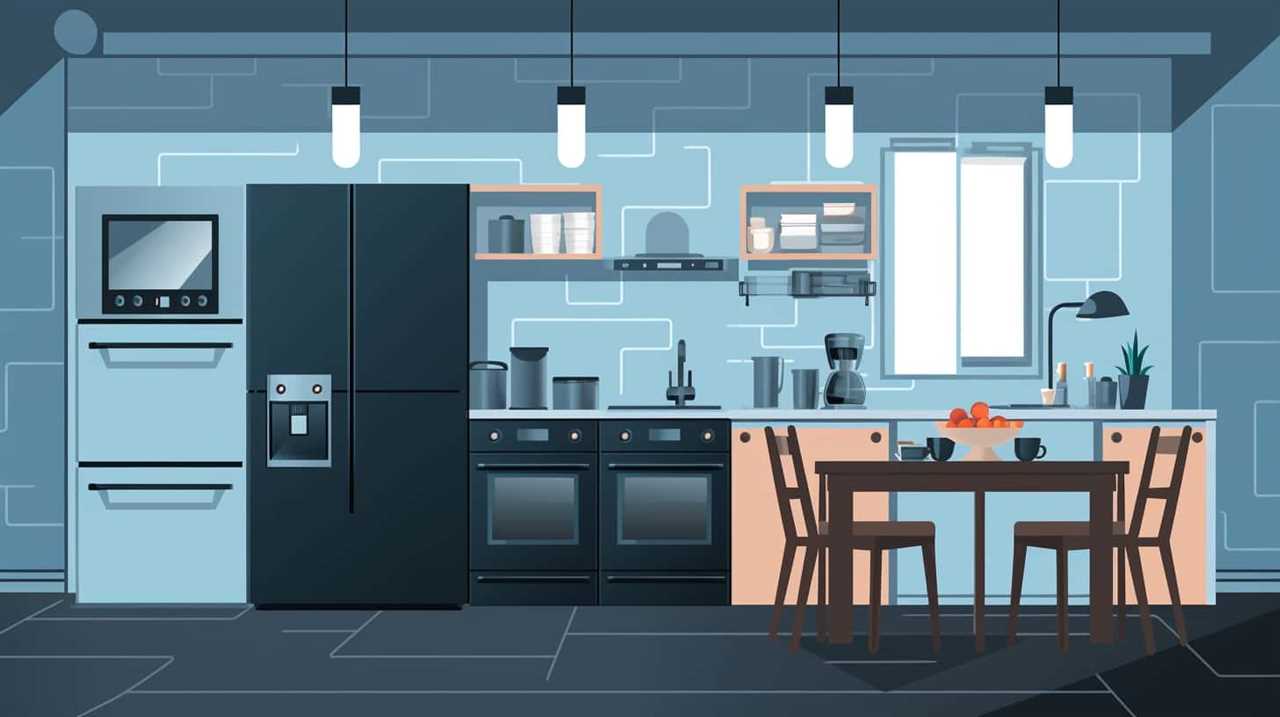
Here are three compelling reasons why you should consider installing a smart thermostat:
- Energy savings: Smart thermostats allow you to program temperature settings based on your daily routine. With the ability to adjust the temperature automatically, you can avoid wasting energy when nobody is home or during sleeping hours. This feature alone can significantly reduce your heating and cooling costs.
- Remote control: One of the most convenient features of a smart thermostat is the ability to control it remotely using your smartphone or tablet. Whether you’re at work or on vacation, you can easily adjust the temperature in your home to ensure comfort and energy efficiency.
- Learning capabilities: Many smart thermostats have learning capabilities that adapt to your preferences and habits over time. They can analyze your behavior and adjust temperature settings accordingly, maximizing energy efficiency without sacrificing comfort.
Energy-Efficient Windows
Installing energy-efficient windows is another effective way to optimize energy efficiency in our homes. Energy-efficient windows are designed to reduce heat transfer and minimize the amount of energy needed to heat or cool our homes. These windows are made with advanced technologies such as low-emissivity (low-E) coatings, multiple panes, and gas fills.
To give you a better idea of the benefits of energy-efficient windows, take a look at the table below:
| Benefits of Energy-Efficient Windows | |||
|---|---|---|---|
| 1. Reduced energy consumption | 2. Lower heating and cooling costs | 3. Enhanced comfort and indoor air quality | 4. Reduced environmental impact |
Energy-efficient windows not only help in reducing energy consumption and lowering heating and cooling costs but also contribute to enhanced comfort and indoor air quality. By reducing heat transfer, these windows can help maintain a consistent temperature throughout the year, reducing the need for artificial heating or cooling. This can lead to significant savings on energy bills.
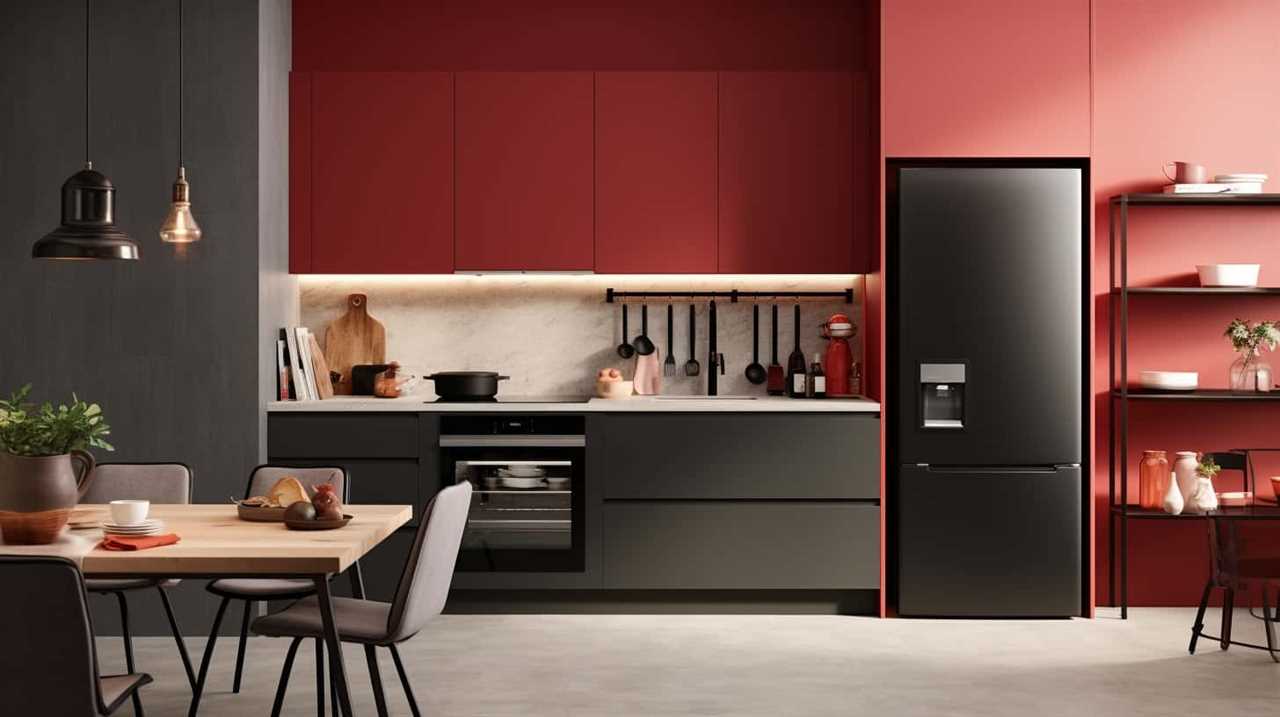
Additionally, energy-efficient windows can also be paired with other energy-saving measures such as energy-efficient blinds and solar panels. Energy-efficient blinds provide an additional layer of insulation and can further reduce heat transfer. Solar panels, on the other hand, can harness the sun’s energy to power our homes, further reducing our reliance on traditional energy sources.
Frequently Asked Questions
Are All LED Light Bulbs Compatible With Any Type of Light Fixture?
LED light bulbs offer numerous energy-saving benefits and can be compatible with many types of light fixtures.
However, it’s important to check the compatibility of the LED bulb with the specific light fixture you have. Some LED bulbs are designed for specific fixtures, such as recessed lighting or track lighting, while others are more versatile.
Make sure to read the packaging or consult the manufacturer’s guidelines to ensure proper compatibility and maximize energy efficiency in your home.

How Can I Determine the Energy Efficiency of an Oven or Stove Before Purchasing It?
When determining the energy efficiency of an oven or stove before purchase, it’s important to look for Energy Star certifications and energy consumption ratings.
These certifications and ratings provide valuable information about the appliance’s energy-saving capabilities. By considering these factors, we can make an informed decision about which oven or stove will be the most energy-efficient and help us save on our energy bills.
Is It Necessary to Hire a Professional for the Installation of Energy-Efficient Windows?
When it comes to the installation process of energy-efficient windows, it all depends on your DIY skills and comfort level. While some people may feel confident tackling this project themselves, others may prefer hiring a professional for a seamless and efficient installation.
It’s important to consider factors like proper measurements, sealing, and insulation to ensure maximum energy savings. In the end, the decision between DIY and professional installation should be based on your expertise and the complexity of the task.

Can a Smart Thermostat Be Controlled Remotely Through a Mobile App?
Yes, a smart thermostat can be controlled remotely through a mobile app, providing numerous benefits and convenience.
With a smart thermostat, you can easily adjust the temperature of your home from anywhere using your smartphone. This allows you to make changes to your heating or cooling settings even when you’re not at home, saving energy and ensuring comfort.
The remote control feature of a smart thermostat adds convenience and flexibility to managing your home’s temperature.
What Are the Key Factors to Consider When Selecting an Energy-Efficient Water Heater?
When selecting an energy-efficient water heater, there are several key factors to consider.

First, look for a model that has a high energy efficiency rating, such as an Energy Star certification.
Additionally, consider the size and capacity of the water heater, as well as the type of fuel it uses.
Finally, look for features such as insulation and timers that can help optimize energy savings.
Conclusion
In conclusion, when it comes to saving energy and money, choosing energy-efficient home appliances is the way to go.
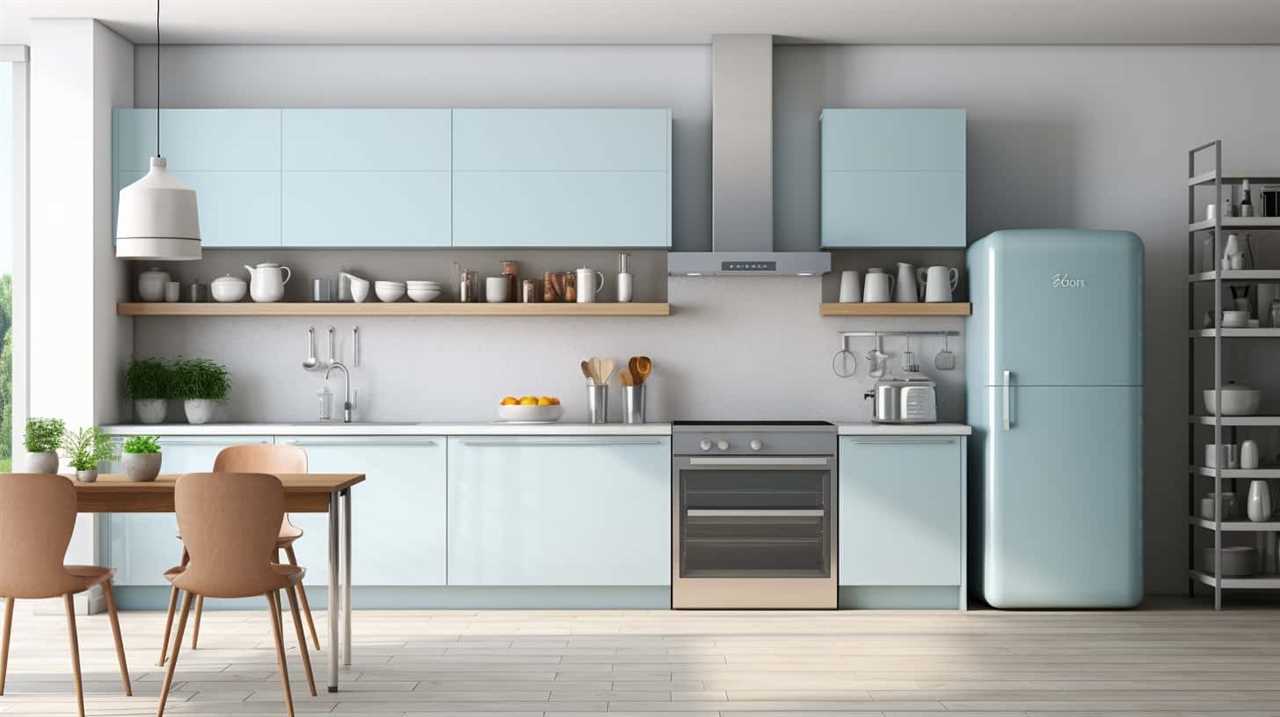
From refrigerators to washing machines, dishwashers to air conditioners, each appliance plays a role in reducing our carbon footprint.
By opting for LED light bulbs, smart thermostats, and energy-efficient windows, we can further maximize our savings.
So let’s make a wise investment and enjoy the benefits of a more eco-friendly and cost-effective home.
Remember, every little bit helps!
